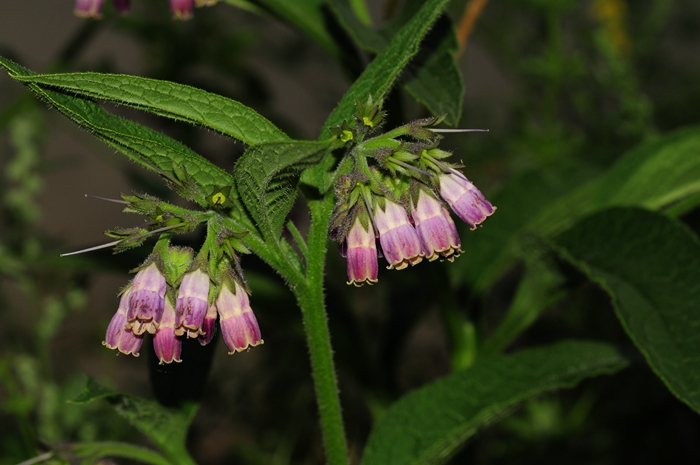- Scientific Name: Symphytum officinale L.
- Ref: Sp. Pl.:136. 1753
- Synonyms:
- Symphytum album Steud.
- S. ambiguum Pau
- S. besseri Zaver.
- S. bohemicum F.W.Schmidt
- S. commune Faegri
- S. consolida Gueldenst.
- S. elatum Tausch
- S. majus Bubani
- S. microcalyx Opiz
- S. molle Janka
- S. patens Sibth.
- S. peregrinum Ledeb.
- S. rakosiense (Soó) Pénzes
- S. stenophyllum Beck
- English Common Name: common comfrey, true comfrey, boneset, knitbone, consound, slippery-root
- Chinese Common Name: 聚合草 jùhé∙cǎo, 友谊草 yǒuyì∙cǎo, 爱国草 àiguó∙cǎo
- Japanese Common Name: ヒレハリソウ [鰭玻璃草] hireharisō, コンフリー (comfrey) konfurī
- Family: Boraginaceae
- Genus: Symphytum
- Distribution: Forests. Fujian, Hebei, Liaoning, Taiwan, Xinjiang [Kazakhstan, Kyrgyzstan, Russia, Tajikistan, Turkmenistan, Uzbekistan; Europe]
- Photo: Mt. Siguniang, Sichuan
Herbs forming tussocks, 30-90 cm tall, arcuate hispid, short strigose. Main roots purplish brown, stout. Stems erect or ascending, branched. Basal leaves long petiolate, lorate-lanceolate to ovate, 30-60 × 10-20 cm, apex acuminate; middle and upper stem leaves sessile, smaller, base decurrent. Inflorescences many flowered. Calyx parted nearly to base; lobes lanceolate, apex acuminate. Corolla light purple, purple-red, or yellowish white, 1.4-1.5 cm; throat appendages ca. 4 mm, not exserted beyond limb; lobes triangular, apex revolute. Filaments ca. 3 mm; lower part nearly as wide as anthers; anthers ca. 3.5 mm, apex with somewhat prominent connective. Ovary usually sterile, occasionally only 1 mericarp develops in a few flowers. Nutlets black, oblique ovoid or ovoid, 3-4 mm, smooth, shiny. Fl. May-Oct. 2n = 24 + 0-4b, 26, 32-45*, 46-48, 56. (Flora of China)
